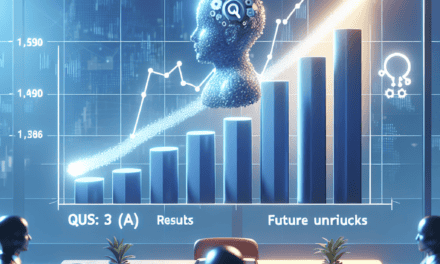“Revolutionizing Digital Assets: Michael Saylor’s Vision for Microsoft’s Future”
Introduction
In a bold and strategic move, Michael Saylor, the co-founder and executive chairman of MicroStrategy, presented a billion-dollar pitch to Microsoft CEO Satya Nadella, aiming to revolutionize the integration of business intelligence and cloud computing. Saylor, known for his visionary approach and advocacy for digital transformation, proposed a partnership that would leverage MicroStrategy’s advanced analytics capabilities with Microsoft’s robust cloud infrastructure. This collaboration sought to empower enterprises with unparalleled data insights, driving efficiency and innovation across industries. By aligning with Microsoft’s expansive ecosystem, Saylor envisioned a future where data-driven decision-making becomes the cornerstone of business strategy, positioning both companies at the forefront of the digital economy.
The Visionary Approach: Michael Saylor’s Strategic Pitch to Microsoft
In the ever-evolving landscape of technology, visionary leaders often emerge with bold ideas that have the potential to reshape industries. One such leader is Michael Saylor, the co-founder and executive chairman of MicroStrategy, who has recently made headlines with his ambitious pitch to Microsoft CEO Satya Nadella. Saylor’s proposal, which revolves around the integration of Bitcoin into Microsoft’s ecosystem, is not only a testament to his forward-thinking approach but also a reflection of the growing influence of cryptocurrency in the corporate world.
To understand the significance of Saylor’s pitch, it is essential to consider the context in which it was made. Over the past few years, Bitcoin has transitioned from a niche digital currency to a mainstream financial asset, attracting the attention of institutional investors and corporations alike. Saylor, a prominent advocate for Bitcoin, has been at the forefront of this movement, having led MicroStrategy to invest billions of dollars in the cryptocurrency. His belief in Bitcoin’s potential as a store of value and a hedge against inflation has been unwavering, and he sees an opportunity for Microsoft to leverage this potential.
Saylor’s pitch to Nadella is centered around the idea of integrating Bitcoin into Microsoft’s suite of products and services. He envisions a future where Bitcoin could be used as a native currency within Microsoft’s ecosystem, facilitating transactions and enhancing the user experience. By doing so, Microsoft could position itself as a leader in the digital currency space, setting a precedent for other tech giants to follow. This strategic move could also attract a new wave of users and developers to Microsoft’s platform, eager to explore the possibilities of blockchain technology.
Moreover, Saylor argues that incorporating Bitcoin into Microsoft’s operations could provide significant financial benefits. As a decentralized and deflationary asset, Bitcoin has the potential to preserve value over time, offering a safeguard against the volatility of fiat currencies. By holding Bitcoin on its balance sheet, Microsoft could not only diversify its assets but also potentially realize substantial gains as the cryptocurrency appreciates in value. This financial strategy aligns with Saylor’s own approach at MicroStrategy, where he has successfully leveraged Bitcoin to enhance the company’s financial position.
Transitioning from the financial implications, Saylor also highlights the technological synergies that could arise from this integration. Microsoft’s expertise in cloud computing, artificial intelligence, and cybersecurity could be harnessed to develop innovative solutions that enhance the functionality and security of Bitcoin transactions. This collaboration could lead to the creation of new tools and services that empower businesses and individuals to harness the full potential of digital currencies, further solidifying Microsoft’s position as a technology leader.
In conclusion, Michael Saylor’s billion-dollar pitch to Satya Nadella is a bold and visionary proposal that underscores the transformative potential of Bitcoin. By integrating this digital currency into its ecosystem, Microsoft could not only capitalize on the financial and technological benefits but also pave the way for a new era of innovation in the tech industry. As the world continues to embrace digital currencies, the decisions made by industry leaders like Nadella will play a crucial role in shaping the future of finance and technology. Saylor’s strategic pitch serves as a reminder of the importance of visionary thinking in navigating the complexities of the modern business landscape.
Billion-Dollar Ideas: How Saylor Aims to Transform Microsoft
In the ever-evolving landscape of technology, visionary leaders often emerge with transformative ideas that have the potential to reshape industries. One such visionary is Michael Saylor, the co-founder and executive chairman of MicroStrategy, who has recently set his sights on Microsoft. Saylor’s billion-dollar pitch to Microsoft CEO Satya Nadella is not just a proposal; it is a bold vision aimed at revolutionizing the way Microsoft operates and competes in the global market. At the heart of Saylor’s proposal is the integration of Bitcoin into Microsoft’s financial ecosystem. Saylor, a well-known advocate for Bitcoin, believes that the cryptocurrency holds the key to unlocking unprecedented value for Microsoft. By incorporating Bitcoin into its balance sheet, Microsoft could potentially hedge against inflation, enhance its financial stability, and attract a new wave of tech-savvy investors. This move, according to Saylor, would not only solidify Microsoft’s position as a leader in innovation but also set a precedent for other tech giants to follow.
Transitioning from the financial implications, Saylor’s pitch also delves into the technological advancements that could arise from such an integration. He envisions a future where Microsoft’s cloud services, particularly Azure, could leverage blockchain technology to offer enhanced security and transparency. By doing so, Microsoft could provide its clients with cutting-edge solutions that address the growing demand for data privacy and integrity. This strategic shift could position Azure as the go-to platform for businesses seeking reliable and secure cloud services, thereby expanding Microsoft’s market share in the cloud computing sector. Furthermore, Saylor’s proposal extends to the realm of artificial intelligence. He suggests that by harnessing the power of decentralized networks, Microsoft could develop AI systems that are not only more efficient but also more ethical. Decentralization, in Saylor’s view, could mitigate the risks associated with data monopolies and ensure that AI technologies are developed in a manner that respects user privacy and autonomy. This approach aligns with Microsoft’s commitment to responsible AI and could enhance its reputation as a leader in ethical technology development.
In addition to these technological advancements, Saylor emphasizes the cultural shift that could accompany his proposed changes. By embracing Bitcoin and blockchain technology, Microsoft could foster a culture of innovation and adaptability. This cultural transformation could attract top talent from around the world, eager to work for a company that is at the forefront of technological evolution. Moreover, it could inspire existing employees to think creatively and push the boundaries of what is possible, ultimately driving Microsoft’s growth and success. As Saylor presents his billion-dollar pitch to Satya Nadella, he acknowledges the challenges that such a transformation would entail. However, he remains confident that the potential rewards far outweigh the risks. By taking bold steps towards integrating Bitcoin and blockchain technology, Microsoft could not only enhance its financial and technological capabilities but also redefine its role in the global tech industry.
In conclusion, Michael Saylor’s ambitious proposal to Microsoft CEO Satya Nadella is a testament to his visionary thinking and unwavering belief in the transformative power of technology. By embracing Bitcoin and blockchain, Microsoft has the opportunity to lead the charge in a new era of innovation, setting a standard for others to follow. As the world watches, the question remains: will Microsoft seize this opportunity to transform itself and, in doing so, reshape the future of technology?
Tech Titans Unite: The Potential Impact of Saylor’s Proposal on Microsoft
In the ever-evolving landscape of technology, strategic partnerships and innovative proposals often serve as catalysts for transformative change. One such proposal that has recently captured the attention of industry insiders is Michael Saylor’s billion-dollar pitch to Microsoft CEO Satya Nadella. As the co-founder and executive chairman of MicroStrategy, Saylor is no stranger to bold moves, particularly in the realm of cryptocurrency and business intelligence. His latest overture to Microsoft, however, could potentially redefine the tech giant’s trajectory in the digital economy.
At the heart of Saylor’s proposal is the integration of Bitcoin into Microsoft’s vast ecosystem. This idea is not entirely surprising, given Saylor’s well-documented advocacy for Bitcoin as a strategic asset. He has consistently argued that Bitcoin represents a superior store of value, especially in an era marked by economic uncertainty and inflationary pressures. By incorporating Bitcoin into Microsoft’s financial framework, Saylor suggests that the company could not only enhance its balance sheet but also position itself as a leader in the burgeoning field of digital finance.
Transitioning from the theoretical to the practical, Saylor’s proposal outlines several potential applications for Bitcoin within Microsoft’s operations. For instance, he envisions the use of Bitcoin as a treasury reserve asset, which could provide Microsoft with a hedge against currency devaluation. Additionally, Saylor proposes the integration of Bitcoin into Microsoft’s suite of products and services, such as Azure and Microsoft 365, thereby offering customers new ways to transact and manage digital assets. This move could potentially attract a new segment of tech-savvy users who are increasingly interested in cryptocurrency solutions.
Moreover, Saylor’s pitch to Nadella is not solely focused on financial innovation. It also touches upon the broader implications of blockchain technology, which underpins Bitcoin. By leveraging blockchain, Microsoft could enhance the security and transparency of its cloud services, thereby addressing growing concerns about data privacy and cyber threats. This aspect of the proposal aligns with Microsoft’s ongoing commitment to building trust in technology, a principle that Nadella has championed throughout his tenure as CEO.
While the potential benefits of Saylor’s proposal are compelling, it is important to consider the challenges and risks associated with such a bold move. The volatility of Bitcoin, for instance, remains a significant concern for many corporations. Integrating a highly volatile asset into Microsoft’s financial strategy could introduce new risks that need to be carefully managed. Furthermore, regulatory scrutiny of cryptocurrencies is intensifying worldwide, and any move by Microsoft to embrace Bitcoin would likely attract attention from regulators.
Despite these challenges, the potential impact of Saylor’s proposal on Microsoft cannot be understated. If executed successfully, it could position Microsoft at the forefront of the digital finance revolution, setting a precedent for other tech giants to follow. Moreover, it could catalyze further innovation within the company, as developers and engineers explore new ways to integrate blockchain technology into existing and future products.
In conclusion, Michael Saylor’s billion-dollar pitch to Satya Nadella represents a bold vision for the future of Microsoft. By embracing Bitcoin and blockchain technology, Microsoft has the opportunity to not only enhance its financial strategy but also to lead the charge in the digital transformation of the global economy. As the dialogue between these tech titans continues, the world watches with anticipation, eager to see how this proposal might shape the future of one of the most influential companies in the world.
Innovation at Scale: Saylor’s Blueprint for Microsoft’s Future
In the ever-evolving landscape of technology, innovation is the lifeblood that sustains industry giants. Michael Saylor, the co-founder and executive chairman of MicroStrategy, has long been a visionary in the tech world. His recent billion-dollar pitch to Microsoft CEO Satya Nadella underscores his commitment to pushing the boundaries of innovation at scale. Saylor’s proposal is not merely a business transaction; it is a blueprint for Microsoft’s future, aiming to leverage cutting-edge technologies to propel the company into a new era of growth and influence.
At the heart of Saylor’s pitch is the integration of advanced analytics and artificial intelligence into Microsoft’s already robust ecosystem. By harnessing the power of data, Saylor envisions a future where Microsoft can offer unprecedented insights and solutions to its global clientele. This approach aligns seamlessly with Nadella’s vision of a cloud-first, mobile-first world, where data-driven decision-making is paramount. Saylor’s strategy emphasizes the importance of not just collecting data, but transforming it into actionable intelligence that can drive business outcomes.
Moreover, Saylor’s proposal highlights the potential of blockchain technology as a transformative force for Microsoft. While blockchain is often associated with cryptocurrencies, its applications extend far beyond digital currencies. Saylor suggests that Microsoft could utilize blockchain to enhance security, streamline operations, and foster transparency across its platforms. This would not only fortify Microsoft’s infrastructure but also position the company as a leader in the burgeoning field of decentralized technologies.
Transitioning from theory to practice, Saylor’s pitch includes a detailed roadmap for implementation. He advocates for a phased approach, beginning with pilot projects that can demonstrate the tangible benefits of these technologies. By starting small and scaling up, Microsoft can mitigate risks while maximizing the impact of its investments. This methodical strategy ensures that innovation is not just a buzzword, but a concrete reality that delivers measurable results.
Furthermore, Saylor’s vision extends to the realm of partnerships and collaborations. He proposes that Microsoft forge alliances with other tech leaders and startups to foster a culture of innovation. By creating a network of collaborators, Microsoft can tap into a diverse pool of ideas and expertise, accelerating its journey towards becoming a more agile and adaptive organization. This collaborative approach is particularly relevant in today’s interconnected world, where the pace of technological change demands a collective effort.
In addition to technological advancements, Saylor’s blueprint emphasizes the importance of nurturing talent within Microsoft. He advocates for investing in employee development programs that equip the workforce with the skills needed to thrive in a rapidly changing environment. By fostering a culture of continuous learning and innovation, Microsoft can ensure that its employees are not only prepared for the challenges of today but are also capable of shaping the future.
In conclusion, Michael Saylor’s billion-dollar pitch to Satya Nadella is more than a proposal; it is a visionary roadmap for Microsoft’s future. By embracing advanced analytics, blockchain technology, strategic partnerships, and talent development, Microsoft can position itself at the forefront of innovation at scale. As the tech landscape continues to evolve, Saylor’s blueprint offers a compelling path forward, one that promises to redefine what is possible for one of the world’s most influential companies.
Financial Mastery: Analyzing Saylor’s Billion-Dollar Pitch to Nadella
In the realm of financial mastery, few figures have captured the attention of the business world quite like Michael Saylor, the co-founder and executive chairman of MicroStrategy. Known for his bold investment strategies and unwavering belief in the potential of digital assets, Saylor has become a prominent advocate for the integration of cryptocurrency into corporate balance sheets. His billion-dollar pitch to Microsoft CEO Satya Nadella exemplifies his strategic acumen and visionary approach to financial management. This pitch, which revolves around the adoption of Bitcoin as a treasury reserve asset, underscores Saylor’s commitment to transforming traditional financial paradigms.
To understand the significance of Saylor’s proposal, it is essential to consider the broader context of the financial landscape. In recent years, the volatility of fiat currencies and the persistent threat of inflation have prompted corporations to seek alternative means of preserving their capital. Saylor, recognizing the potential of Bitcoin as a hedge against inflation and a store of value, has positioned himself as a leading proponent of its adoption by major corporations. His pitch to Nadella is not merely a financial proposition but a call to action for Microsoft to embrace a forward-thinking approach to asset management.
Saylor’s argument is built on the premise that Bitcoin, with its decentralized nature and finite supply, offers a unique opportunity for corporations to safeguard their financial assets. By integrating Bitcoin into its treasury strategy, Microsoft could potentially enhance its financial resilience and capitalize on the long-term appreciation of this digital asset. Saylor’s pitch is further bolstered by the growing acceptance of Bitcoin among institutional investors and the increasing recognition of its potential to revolutionize the financial sector. This trend, coupled with the technological prowess of Microsoft, presents a compelling case for the company to consider Bitcoin as a strategic asset.
Moreover, Saylor’s pitch to Nadella is not solely focused on the financial benefits of Bitcoin adoption. It also highlights the potential for Microsoft to position itself as a leader in the digital transformation of the financial industry. By embracing Bitcoin, Microsoft could leverage its technological expertise to develop innovative solutions that facilitate the integration of digital assets into mainstream financial systems. This strategic move could not only enhance Microsoft’s competitive edge but also solidify its reputation as a pioneer in the digital economy.
Transitioning from the theoretical to the practical, Saylor’s pitch also addresses the logistical considerations of Bitcoin adoption. He emphasizes the importance of robust security measures and regulatory compliance to ensure the safe and efficient management of digital assets. By outlining a comprehensive framework for Bitcoin integration, Saylor provides a roadmap for Microsoft to navigate the complexities of this emerging asset class. This pragmatic approach underscores his commitment to facilitating a seamless transition for corporations seeking to embrace the potential of digital currencies.
In conclusion, Michael Saylor’s billion-dollar pitch to Microsoft CEO Satya Nadella is a testament to his visionary leadership and financial acumen. By advocating for the adoption of Bitcoin as a treasury reserve asset, Saylor challenges traditional financial paradigms and offers a compelling case for the integration of digital assets into corporate strategies. His proposal not only highlights the potential financial benefits of Bitcoin adoption but also underscores the opportunity for Microsoft to lead the digital transformation of the financial industry. As corporations continue to navigate the complexities of the modern financial landscape, Saylor’s pitch serves as a powerful reminder of the transformative potential of visionary thinking and strategic innovation.
Leadership and Influence: Saylor’s Persuasive Techniques in Action
In the realm of technology and business, few figures have demonstrated the art of persuasion as effectively as Michael Saylor, the co-founder and executive chairman of MicroStrategy. His recent billion-dollar pitch to Microsoft CEO Satya Nadella serves as a compelling case study in leadership and influence. Saylor’s approach is not merely about numbers and potential profits; it is a masterclass in strategic communication, underscoring the importance of vision, credibility, and timing in the art of persuasion.
To begin with, Saylor’s pitch to Nadella was rooted in a deep understanding of both the technological landscape and Microsoft’s strategic objectives. By aligning his proposal with Microsoft’s long-term goals, Saylor was able to present his ideas not as a mere business transaction but as a shared vision for the future. This alignment is crucial in any persuasive endeavor, as it transforms the pitch from a one-sided request into a mutually beneficial opportunity. Saylor’s ability to articulate how his proposal could enhance Microsoft’s existing initiatives, such as cloud computing and artificial intelligence, demonstrated his insight into the company’s priorities and his commitment to contributing to its success.
Moreover, Saylor’s credibility played a significant role in his persuasive efforts. With a track record of successful ventures and a reputation for innovation, Saylor brought a level of authority and trustworthiness to the table. His experience in the tech industry and his leadership at MicroStrategy provided a solid foundation for his arguments, making it easier for Nadella to consider the potential benefits of the proposal. In any persuasive situation, credibility is a powerful tool, as it reassures the audience that the speaker is knowledgeable and reliable. Saylor’s established reputation allowed him to leverage this trust, making his pitch more compelling.
In addition to credibility, Saylor’s timing was impeccable. He approached Nadella at a moment when the tech industry was undergoing significant transformations, with companies increasingly seeking to integrate advanced technologies into their operations. By presenting his proposal during this period of change, Saylor was able to tap into the urgency and momentum of the moment. Timing is often an overlooked aspect of persuasion, yet it can be the difference between a successful pitch and a missed opportunity. Saylor’s awareness of the industry’s dynamics and his ability to seize the right moment added weight to his arguments, making them more persuasive.
Furthermore, Saylor’s communication style was instrumental in his pitch. He employed clear, concise language, avoiding technical jargon that could obscure his message. This clarity ensured that his ideas were accessible and understandable, allowing Nadella to grasp the full scope of the proposal without unnecessary complexity. Effective communication is essential in persuasion, as it facilitates understanding and fosters engagement. Saylor’s ability to convey his ideas in a straightforward manner enhanced his persuasive appeal, making it easier for Nadella to envision the potential impact of the proposal.
In conclusion, Michael Saylor’s billion-dollar pitch to Satya Nadella exemplifies the power of strategic persuasion in leadership. By aligning his proposal with Microsoft’s goals, leveraging his credibility, timing his approach effectively, and communicating clearly, Saylor demonstrated how these elements can be combined to influence decision-making at the highest levels. His approach serves as a valuable lesson for leaders seeking to persuade others, highlighting the importance of vision, trust, timing, and clarity in achieving successful outcomes.
The Future of Technology: Saylor’s Vision for Microsoft Under Nadella
In the rapidly evolving landscape of technology, visionary leaders play a pivotal role in shaping the future. Michael Saylor, a prominent figure in the tech industry, has recently made headlines with his ambitious proposal to Microsoft CEO Satya Nadella. Saylor, known for his strategic acumen and forward-thinking approach, has presented a billion-dollar pitch that could potentially redefine Microsoft’s trajectory in the coming years. As the world becomes increasingly digital, Saylor’s vision for Microsoft under Nadella’s leadership is both bold and transformative.
At the core of Saylor’s proposal is the integration of blockchain technology into Microsoft’s existing infrastructure. Recognizing the transformative potential of blockchain, Saylor argues that its adoption could revolutionize various aspects of Microsoft’s operations, from enhancing security protocols to streamlining supply chain management. By leveraging blockchain, Microsoft could not only improve its internal processes but also offer innovative solutions to its vast customer base. This move, Saylor suggests, would position Microsoft as a leader in the blockchain space, setting a precedent for other tech giants to follow.
Moreover, Saylor emphasizes the importance of artificial intelligence in shaping the future of technology. He envisions a Microsoft that harnesses the power of AI to drive innovation across its product lines. By investing in AI research and development, Microsoft could enhance its existing offerings, such as Azure and Office 365, while also exploring new avenues for growth. Saylor’s pitch highlights the potential for AI to transform industries, from healthcare to finance, and underscores the need for Microsoft to be at the forefront of this technological revolution.
In addition to blockchain and AI, Saylor’s proposal includes a focus on sustainability and environmental responsibility. He advocates for Microsoft to take a leading role in promoting green technology and reducing its carbon footprint. By investing in renewable energy sources and developing eco-friendly products, Microsoft could not only contribute to global sustainability efforts but also appeal to a growing segment of environmentally conscious consumers. Saylor’s vision aligns with Nadella’s existing commitment to sustainability, making it a natural extension of Microsoft’s current initiatives.
Furthermore, Saylor’s pitch addresses the importance of fostering a culture of innovation within Microsoft. He suggests that by encouraging collaboration and creativity among its employees, Microsoft can continue to develop cutting-edge solutions that meet the evolving needs of its customers. This approach, Saylor argues, would not only drive growth but also attract top talent to the company, ensuring its competitive edge in the tech industry.
As Saylor presents his billion-dollar pitch to Nadella, the potential implications for Microsoft are profound. By embracing blockchain, AI, and sustainability, Microsoft could redefine its role in the tech industry and set new standards for innovation and responsibility. Saylor’s vision is not just about technological advancement; it is about creating a future where technology serves as a force for good, driving positive change in society.
In conclusion, Michael Saylor’s proposal to Satya Nadella represents a bold vision for the future of Microsoft. By integrating cutting-edge technologies and prioritizing sustainability, Saylor envisions a Microsoft that leads the way in innovation and responsibility. As Nadella considers this ambitious pitch, the potential for Microsoft to shape the future of technology is immense, offering exciting possibilities for the company and its stakeholders.
Q&A
1. **What was Michael Saylor’s main proposal to Satya Nadella?**
Michael Saylor proposed that Microsoft should adopt Bitcoin as a treasury reserve asset.
2. **Why did Saylor believe Bitcoin was a good fit for Microsoft?**
Saylor argued that Bitcoin’s decentralized nature and potential for appreciation would protect Microsoft’s assets from inflation and currency devaluation.
3. **How did Saylor suggest Microsoft could benefit from Bitcoin?**
He suggested that holding Bitcoin could enhance Microsoft’s balance sheet and potentially increase shareholder value.
4. **What was Saylor’s perspective on the future of Bitcoin?**
Saylor was bullish on Bitcoin, viewing it as a superior store of value compared to traditional fiat currencies.
5. **Did Saylor propose any specific strategies for Microsoft to acquire Bitcoin?**
Saylor recommended that Microsoft could use excess cash reserves to purchase Bitcoin gradually over time.
6. **What were the potential risks Saylor acknowledged in his pitch?**
Saylor acknowledged the volatility of Bitcoin but argued that the long-term benefits outweighed the risks.
7. **How did Saylor’s own company’s actions support his pitch to Microsoft?**
Saylor’s company, MicroStrategy, had already invested heavily in Bitcoin, demonstrating his confidence in the strategy he was proposing to Microsoft.
Conclusion
Michael Saylor’s billion-dollar pitch to Microsoft CEO Satya Nadella likely centered around the strategic integration of Bitcoin and blockchain technology into Microsoft’s ecosystem. Saylor, a prominent advocate for Bitcoin, may have emphasized the potential for Bitcoin to serve as a robust store of value and a hedge against inflation, aligning with Microsoft’s long-term financial strategies. Additionally, he might have highlighted the technological synergies between blockchain and Microsoft’s cloud services, suggesting innovative applications that could enhance Microsoft’s competitive edge. The pitch would have aimed to position Microsoft at the forefront of the digital currency revolution, leveraging Bitcoin’s growing acceptance and Saylor’s expertise to drive future growth and innovation.





